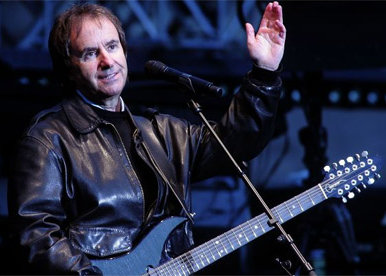| B i o g r a p h y |
 Chris de Burgh (born Christopher John Davison,
15 October 1948) is an Argentinian born British-Irish
singer-songwriter. He is most famous for his 1986 love song "The Lady in
Red", which reached number-one in Belgium, Canada, Ireland, Norway, and
the United Kingdom.
Chris de Burgh (born Christopher John Davison,
15 October 1948) is an Argentinian born British-Irish
singer-songwriter. He is most famous for his 1986 love song "The Lady in
Red", which reached number-one in Belgium, Canada, Ireland, Norway, and
the United Kingdom.
De Burgh was born in Venado Tuerto, Argentina, to Colonel Charles
Davison, a British diplomat, and Maeve Emily de Burgh, an Irish
secretary. His father had substantial farming interests, and he spent
much of his early years in Malta, Nigeria and Zaire, as he, his mother
and brother accompanied Colonel Davison on his diplomatic and
engineering work. The Davisons finally settled in Bargy Castle, County
Wexford, a twelfth-century castle in Ireland bought by his maternal
grandfather, General Sir Eric de Burgh, a former Chief of the General
Staff in India and from a distinguished Hiberno-Norman family. The
castle was converted into a hotel where Chris gained much early
experience performing to the guests and he later assumed de Burgh as his
stage name. After attending Marlborough College in Wiltshire, England,
de Burgh went on to graduate from Trinity College, Dublin with a Master
of Arts degree in French, English and History.
Chris de Burgh signed his first contract with A&M Records in
1974, and supported Supertramp on their Crime of the Century tour,
building himself a small fan base. His début album, Far Beyond These
Castle Walls, was a folk-tinged stab at fantasy in the tradition of the
Moody Blues. It failed to chart upon its release in February 1975. Five
months later, he released a single called "Turning Round" from the
album, released outside the UK and Ireland as "Flying". It failed to
make an impression in the UK, but it stayed on top of the Brazilian
charts for 17 weeks. This became a familiar pattern for the
singer/songwriter, as every one of his '70s albums failed to chart in
the UK or US while they racked up big sales in continental European and
South American countries. In 1981, he had his first UK chart entry with
Best Moves, a collection culled from his early albums. It set the stage
for 1982's Rupert Hine produced The Getaway, which reached number 30 in
the UK charts and number 43 in the US, thanks to the eerie single "Don't
Pay the Ferryman". Chris de Burgh's follow-up album, Man on the Line,
also performed well, charting at 69 in the US and 11 in the UK.
Chris de Burgh had an across-the-board success with the ballad "The Lady
in Red" in late 1986; the single became a number one hit in the UK
(number three in America) and its accompanying album, Into the Light,
reached number two in the UK. (number 25 in the U.S.). That Christmas
season, a re-release of de Burgh's 1976 Christmas song "A Spaceman Came
Travelling" became a Top 40 hit in the UK. Flying Colours, his follow-up
to Into the Light, entered the British charts at number one upon its
1988 release, yet it failed to make the American charts. De Burgh never
hit the US charts again and his commercial fortunes began to slide
slightly in Britain in the early 1990s, yet he retained a following
around the world. This is mainly due to inactivity of his previous
recording label A&M Records UK division in U.S.
In 2007, a concert in Tehran was planned for mid-2008, together with
local band Arian, which would have made Chris de Burgh the first western
pop singer to perform in Iran since the 1979 revolution. However the
concert never went ahead because he had not been given permission by the
Iranian authorities to perform in the country.